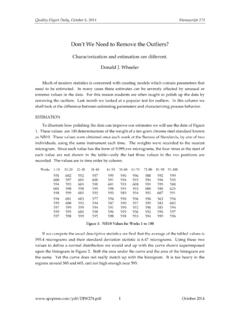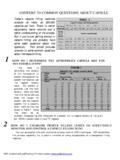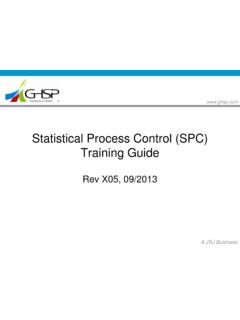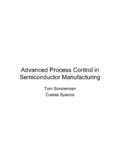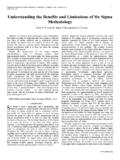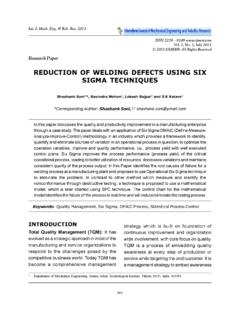Transcription of 129 New Terminology - SPC Press
1 SPC Ink, 1998, No. 129 1998 SPC Press1 The New TerminologyDonald J. WheelerStatistical process control has been around for over 70 years. However, there is today considerableconfusion about the nature and purpose of SPC. I believe this is because many have sought to reshapeSPC according to their own background and hear the words Statistical process control and immediately think of classical statisticalprocedures. They try to fit SPC into this framework of parameters, distributional assumptions, tests ofhypotheses, and confidence levels. Of course, when this group tries to share their version of SPC they aremet with that same total lack of comprehension which is the fate of classical statistics.
2 But statisticians areaccustomed to rejection, so this is nothing hear the words Statistical process control and think of process control techniques. SPC isthought of as a manual process - control technique to be used to maintain the status quo for a process . It ismerely a process monitoring technique, to be used after you have already gotten the process into asatisfactory state. And, since this is what SPC is about, wouldn t you like to know about some of theneat algorithmic process - control techniques and process modeling techniques that have been developedin the past few years?
3 This group would be glad to give you a course or sell you some software. Butonce again, there is a hurdle of truly mathematical proportions to be overcome. The faint of heart neednot apply. Those without calculus should not enter in to this third group uses the word control to denote conformance to specifications, and so when they hearthe words Statistical process control they think about trying to produce product within this perspective, they think of SPC as a complex route to a simple objective, and accordingly theytry to simplify SPC. This group tends to want to bypass the computations based on the data and insteaduse the specifications to set action limits.
4 While this simplicity sells well, it has the unfortunatecharacteristic of completely misrepresenting what SPC is all about. Those who use these simplifiedapproaches may meet with some limited success, but because their objective falls short of what can bedone, because they do not seek to get the most out of their processes, they do not reap the benefitsavailable from SPC. The reality falls short of the promise, and the users return to sorting as a way oflife make enough stuff and some of it is likely to be then there is the group that is confused by the three groups above.
5 They do not understand thefirst two interpretations of SPC, but they presume that there must be something to all the mathematics,and so they encumber SPC with all sorts of distributional assumptions, cautions, and , out of this confusion, they superstitiously place restrictions on how and when to use control then they are suprised when people get tired of standing on one leg, facing east, at sunrise, prior toplacing their data on a control of this nonsense! Statistical process control is not about statistics, it is not about processcontrol, and it is not about conformance to specifications.
6 While SPC can be used in all of these ways, it ismuch more than any one of these narrow interpretations. It is, at its heart, about getting the most fromyour processes. It is about the continual improvement of processes and outcomes. And, it is, first andThe New TerminologyDonald J. , a way of thinking with some tools it is easy to focus on the tools, and while it is easy to teach the tools, the tools are secondary tothe way of thinking. Learn the tools and you will have nothing. You will not know what to do. You willnot know how to use the tools and practice the way of thinking that undergirds the tools and you will begin an unendingjourney of continual improvement.
7 Without major capital expenditures you will discover how to increaseboth quality and productivity, and thereby to improve your competitive position. This is not a has been proven time after time. But, of course, the successful companies are reluctant to share thissecret with their competitors (even if their competitors could understand it).And this is where the nomenclature gets in the way. As outlined above, as long as we use the wordsStatistical process control we will stimulate people to think about techniques for maintaining the statusquo. As long as we talk about control charts we will continue to be misunderstood as described abovesimply because of the many different connotations of the word control .
8 The words out of control generally bring to mind the image of a disgruntled worker going crazy and shooting his fellow the other hand, the words in control are used to mean under my control and in specification. So, to understand just what Shewhart meant when he used the word control , we return to his owndefinition: A phenomenon will be said to be controlled when,through the use of past experience,we can predict, at least within limits,how the phenomenon will vary in the future. Here we see that predictability is the essence of Shewhart s use of the word control .
9 A phenomenon that iscontrolled is predictable, and conversely, a phenomenon that is not controlled is how the sense of Shewhart s definition is unchanged by the following paraphrase:A process will be said to be predictable when,through the use of past experience,we can describe, at least within limits,how the process will behave in the substitution of these four words does not change the thrust of Shewhart s idea, but it does avoidsome of the confusion that his original words have , the control chart is, in effect, a process behavior chart.
10 It examines the data from a process to see ifthe process is predictable or unpredictable. When a process is unpredictable it will display the excessivevariation that is the result of assignable causes. When a process is predictable it will display the routinevariation that is characteristic of common , in order to better win the hearts and minds of others, and to encourage them to enjoy thebenefits of Shewhart s creation, I propose that we begin to use the following Terminology :Instead of Statistical process control ,we talk about Continual has the advantage of focusing attention on the job of making things better by getting the most out ofour current systems and processes as opposed to merely monitoring the process to maintain the New TerminologyDonald J.




